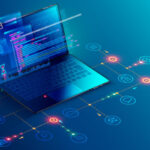We explain what hardware and software are and what functions each one fulfills. Also, how they are composed and examples.

What are hardware and software?
In computing, the terms hardware and software are used to refer to the two different and complementary aspects of any computerized system: the physical and tangible, on the one hand; and the virtual and digital, on the other. Body and soul, respectively, of any computer system.
When we talk about hardware (from English hardrigid, and wareproduct) we refer to the mechanical, electrical or electronic set of the real parts that make up the body of a computer, that is, the boards, cards, integrated circuits, mechanisms, electrical devices, responsible for processing, support and connection of the machine.
This hardware is classified according to its function in the overall system process:
- Storage hardware. It operates as the “memory” of the computer, where information and data are stored. It can be primary storage (internal, inside the computer) or secondary (removable, portable).
- Processing hardware. The heart of the system is where calculations are carried out and logical operations are resolved.
- Peripheral hardware. These are the attachments and accessories that are incorporated into the system to communicate with the outside world and/or provide new functions. It can be of three types, in turn:
- input hardware. It is used to enter data into the system, either by the user or operator, or from other systems and computers on the network.
- Output hardware. Similarly, it allows you to recover information from the system, or share it over telecommunications networks.
- Mixed hardware. Executes input and output functions at the same time.
When we talk about software, however, we refer to the virtual content of the system: the programs, applications, instructions and communication protocols that serve as an interface with the user and control how the system operates and they give it meaning. This is the “mind” of the system.
Said software can also be classified according to its function in the system:
- Yesoperating system (or system software). They are responsible for regulating the way the system operates and guaranteeing its continuity, serving as a basis for other programs or applications, and allowing interface with the user. They are usually built into the factory system.
- Application software. This is the name given to all the additional programs that are incorporated into the computer, already equipped with an operating system, with the purpose of carrying out an endless number of possible tasks: from word processors, spreadsheets, internet browsers, design applications. or video games.
The sum of hardware and software completes the entirety of any computer system.
See also: Application Software.
Hardware and software examples
Some hardware examples:
- Monitors either projectors. Where information and processes are displayed to the user, they are considered output hardware, although touch monitors already exist (which would then be mixed peripherals).
- Keyboard and mouse. Input peripherals par excellence, they allow the entry of user data: through buttons (keys) and through movements and buttons, respectively.
- Webcams. Also called webcamssince they became popular with the arrival of the Internet and videoconferencing, they allow the entry and transmission of audio and video through the system.
- Micropsprayeris. The core of the CPU (Central Processing Unit) is a very powerful microchip, which performs thousands of logical calculations per second.
- Cardyes network. These circuits integrated into the CPU motherboard give you the possibility of interacting with data networks at a distance, either through cables, radio signals, etc.
Some software examples:
- Microsoft Windows. Probably the most popular of the operating systems currently used, it is typical of IBM computers. It allows the user to manage and interact with the different segments of a computer, through a friendly user environment, based on windows and visual representation.
- Mozilla Firefox. An extremely popular Internet browser, available for download without payment. It connects the user to the World Wide Web to perform data searches and other types of virtual operations.
- Microsoft Word. Part of the Microsoft Office package, it is one of the most recognized word processors there is, and includes tools for business, database management, presentation preparation, among others.
- Google Chrome. Another Internet browser, offered by the Google company, whose lightness and speed made it quickly popular among Internet users. In addition, it opened the door to projects for a Google operating system.
- Adobe Photoshop. an acquaintance image editing and visual content creation application, useful for graphic design and photographic retouching, product of the company Adobe Inc.





